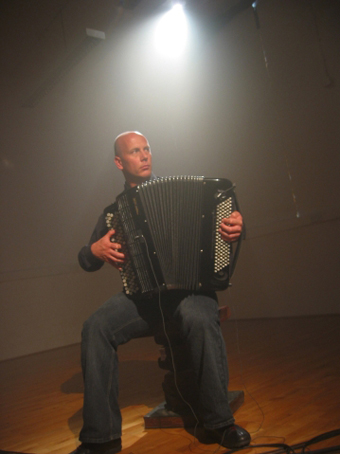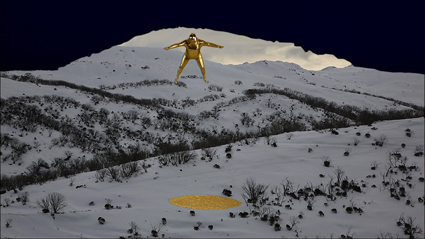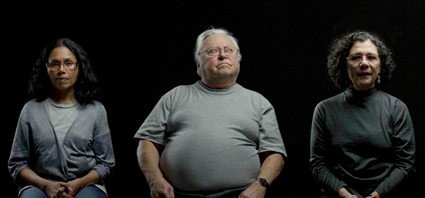in the loop nov 20: quick picks
realtime’s advance word
encoded, stalker
We’ve come to expect something a little bit spectacular from David Clarkson’s work with Stalker over the company’s 20-plus year history. Generally this has been the result of the raw physicality and daring, his shows frequently involving vertiginous acrobatic stilt walking—and even a giant catapult. However for his latest work, Encoded, Clarkson has gone totally high-tech.
Encoded explores how the body effects space and space effects the body. Projected environments respond specifically to the movement of dancers and aerialists, triggered by infrared tracking. In addition the dancers wear digital costumes—self-mounted laser projectors that bathe the performer in ever-shifting designs. Clarkson has enlisted an impressive design team to create this vision including Alejandro Rolandi, whose recent production Return to Trees at Carriageworks was an impressive physical theatre piece in itself; Andrew Johnston, an interactive design specialist and co-director of the Creativity and Cognition Studios at UTS; and Sam Clarkson, an award winning game designer and “world leader in photo?real graphics research, development and implementation” (press release). Clarkson has also enlisted Paul Selwyn Norton, longtime dancer with William Forsythe’s Ballet Frankfurt, as choreographer. See the video above and book your tickets for Encoded’s short season.
Stalker, Encoded, director David Clarkson, Carriageworks Nov 28-Dec 1; http://www.carriageworks.com.au/; http://www.stalker.com.au/
on loop, ensemble offspring

James Crabb
photo Lizzie Jones
James Crabb
Ensemble Offspring have presented an ambitious and innovative program in 2012. Their last concert for the year, to be performed in both Sydney and Melbourne, looks to be no exception (see our realtime tv video interview and also the preview of Tura’s 25th birthday celebrations). In Sydney they will take over both the theatre (Bay 20) and the vast foyer of Carriageworks to present On Loop. Featured performers include the Australian turntablist Martin Ng and Scottish accordionist James Crabb (see a review of his Campbelltown Arts Centre concert in RealTime 112). UK composer Matthew Wright, whose work spans both dots-on-paper composition and turntablism, will also be in the country to present his new work, Totem for Sydney. Amsterdam-based pianist Cor Fuhler is no stranger to Australia, but is more often found in the improv scene. He will present a new composition, When Snoopy Met Boop. Other works in the concert include Memo by Dutch composer Michel van de Aa (see interview in RT78) and Gavin Bryar’s famous tape-loop work Jesus’ Blood Never Failed Me Yet. There’ll also be an installation in the foyer of ‘old school’ tape loops.
Ensemble Offspring, On Loop; Carriageworks, Sydney, Dec 1;
Melbourne Melbourne Recital Centre, Dec 6; http://ensembleoffspring.com/
(TIP: In Sydney you can make a night of it and see the matinee of Encoded followed by On Loop!)
international space time concerto competition
The finalists in the International Space Time Concerto Competition will be presenting their works in Newcastle, NSW at the end of the month. (For a handy primer on the concerto form by Matthew Lorenzon see our preview of the competition in our May 22 e-dition.) On November 30 the finalists in the Networked Music Performance category—Cat Hope (WA), Greg Schiemer (NSW) and Chow Jun Yan (Singapore)—will present their works via link-ups between performers in Newcastle, Austria, Singapore, China and New Zealand. The works factor in the inevitable latencies (repeat the mantra “bring on the NBN!”) and range from concertos written for pipe organ to string orchestra and an iPhone ensemble. (You can see a realtime tv interview with Cat Hope here; and read about Greg Schiemer’s phone music here.)
The final concert on December 2 at the University of Newcastle’s Harold Lobb Concert Hall presents historic symphonies by composers such as Dvo?ák, Schumann, Prokofiev and Preston performed by finalists in the solo instrumentalists category. These traditional concertos will be combined with the works by finalists in the innovation category such as Orbis Tertius (ACT) who will present Trial of the Ignorant Truth Concerto (2012) which explores equal temperament using instruments such as the erhu, the saz, a musical saw and a microtonal guitar. Also from ACT, John Burgess will present his Concerto (2012) for adapted electric double bass. Getting more physical, Mary Mainsbridge (NSW) will perform her Code-centric Motion (2012) for voice, gesturally controlled digital instrument and orchestra. Perhaps the most genre-bending contribution comes from Robert Jarvis (Vic) who will perform his Concerto for Light Sculpture (2012) using a digital interface called a Monome that allows light and sound to played in tight synchronisation. There is an overall prize pool of $50,000 divided between the category winners.
International Space Time Concerto Competition presented by University of Newcastle in collaboration with Yong Siew Toh Conservatory of Music, Singapore, Central Conservatory of Music, Beijing, Waikato University, New Zealand and Ars Electronica, Austria; Newcastle Conservatorium, Nov 30; University of Newcastle’s Harold Lobb Concert Hall, Dec 2; http://www.spacetimeconcerto.com
body fluid—the seven cycles, john a douglas

John A Douglas, Body Fluid, Saline Ascent (video still)
courtesy the artist
John A Douglas, Body Fluid, Saline Ascent (video still)
In RT106 Ella Mudie wrote about John A Douglas’ 10-hour durational performance at Performance Space: “In a surreal setting melding the chintzy glamour of a lo-fi science fiction film set with the sparse interior of a hospital room, the artist began by lying prostrate on the floor while hooked up to a peritoneal dialysis machine, plastic tube protruding from his rotund Buddha belly. Dressed in a tight, shiny, gold bodysuit that covered eyes, nostrils and mouth, there was a wry humour in its resemblance to both submissive bondage attire and a Hollywood superhero costume gone awry.” (See full review.)
The video backdrop to this performance featured Douglas, in the same gold costume, appearing and disappearing in the distance around a salt lake, in a reference to Nicolas Roeg’s science fiction classic The Man Who Fell to Earth (1976). Douglas will present the continuation of this work at Chalkhorse Gallery from November 22, with photographic and video works of this mysterious golden man wandering the Mallee Country and the Snowy Mountains. Douglas says, “in these mediated figurative landscape works, the imaginary golden figure takes on powers of levitation and flight through the replenishment of bodily fluids within the Australian landscape.” Douglas is currently the inaugural artist-in-residence at the Museum of Human Disease, UNSW, thanks to an Australia Council AIR grant.
Body Fluid—The Seven Cycles, John A Douglas, Chalkhorse Gallery; open Nov 22; http://www.chalkhorse.com.au/
241 years, morrish, osborne, jeyens, rorhrig
Some of us in Sydney had the rare pleasure to spend time embroiled in the circular thoughts and profound whimsy of improvisor Andrew Morrish during Campbelltown Art Centre’s Oh I Wanna Dance With Somebody (to be reviewed in RT112). Fear not if you missed it, there’s more to come. He has teamed up with long time collaborator Tony Osborne as well as two other seasoned improvisers Kevin Jeynes and John Rohrig, to present a touring show called 241 years. We are told that this number is the sum total of the improvisors’ ages. The team has already blasted through Brisbane, will briefly be taking on Dancehouse in Melbourne, and will end their tour in Sydney at Marrickville’s Sidetrack Theatre. (The Sydney season is a double bill with youMove Company’s tenofus which will present solos by Narelle Benjamin, Tony Osborne, Vicki Van Hout, Anton and Angela French.) Who knows what to expect, but from previous outings, the moments of failure are even more intriguing than the moments that succeed.
241 years, Andrew Morrish, Tony Osborne, Kevin Jeynes, John Rohrig; Dancehouse, Melbourne, Nov 21-22, www.dancehouse.com.au ); with youMove Company’s tenofus, Sidetrack Theatre, Sydney, Nov 23-24; http://www.sidetrack.com.au/; http://youmovedance.com.au/
the conversation, jon mark oldmeadow, claudio tocco

The Conversation, Jon Mark Oldmeadow, Claudio Tocco
courtesy the artists
The Conversation, Jon Mark Oldmeadow, Claudio Tocco
Putting a new spin on multi-channel video installation is Jon Mark Oldmeadow and Claudio Tocco’s The Conversation. The installation features three participants who have migrated from Peru, Germany and Sri Lanka sharing memories of their home countries. However, rather than each screen having a fixed and dedicated soundtrack, the audience is supplied with wireless headphones thus receiving different aspects of the soundtrack according to their position in the gallery space. This allows the viewer the freedom to construct their own sense of these stories. Jon Mark Oldmeadow was previously involved in the Safari Team art collective that presented the ambitious Molto Morte and Evolution at the 2008 and 2010 Next Wave festivals respectively.
The Conversation, Jon Mark Oldmeadow, Claudio Tocco, Seventh Gallery, 155 Gertrude Street, Fitzroy; til Dec 1; http://seventhgallery.org/
upraw online gallery
As most things move to virtual platforms, it makes sense that galleries do too, and UpRaw is a prime example. It is a new initiative from the art investment company Art Equity with a focus on selling the work of young and emerging artists, with some rather reasonable price tags ranging from $170 to $2000. There’s a stable of 20 artists with works ranging from the street stencil style of Doug Bartlett to the dusky detailed prints of Kate Piekutowski and the moody Crewdson-esque staged photography of Jack Condon. While the gallery is generally virtual it will have a physical ‘pop-up’ home for two weeks at 174 Crown Street Darlinghurst.
UpRaw, exhibtion 174 Crown Street Darlinghurst, opens Nov 28; http://www.upraw.com.au/
RealTime issue #111 Oct-Nov 2012 pg.






